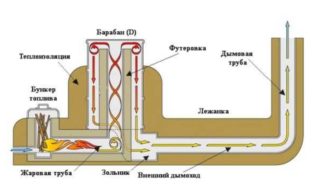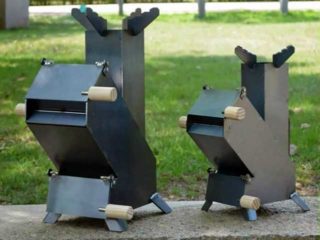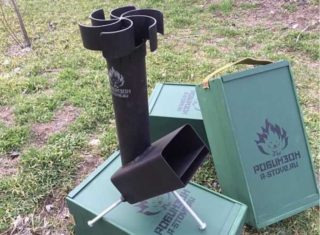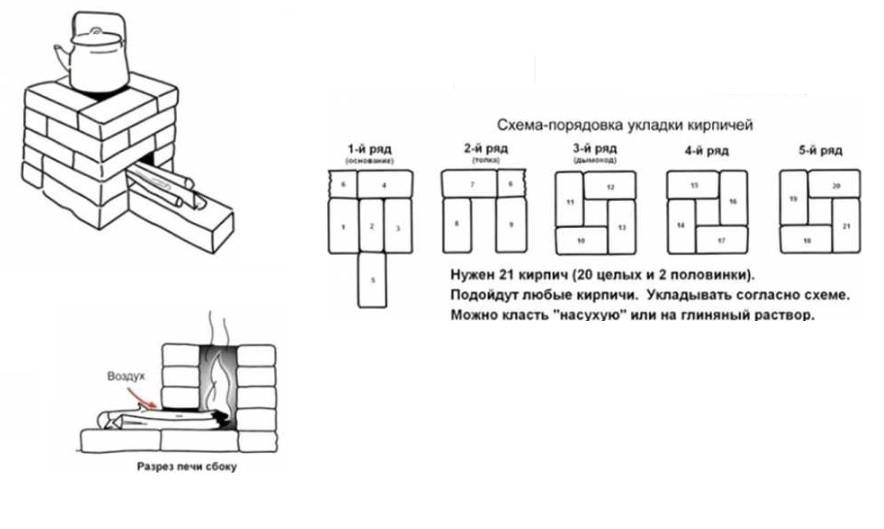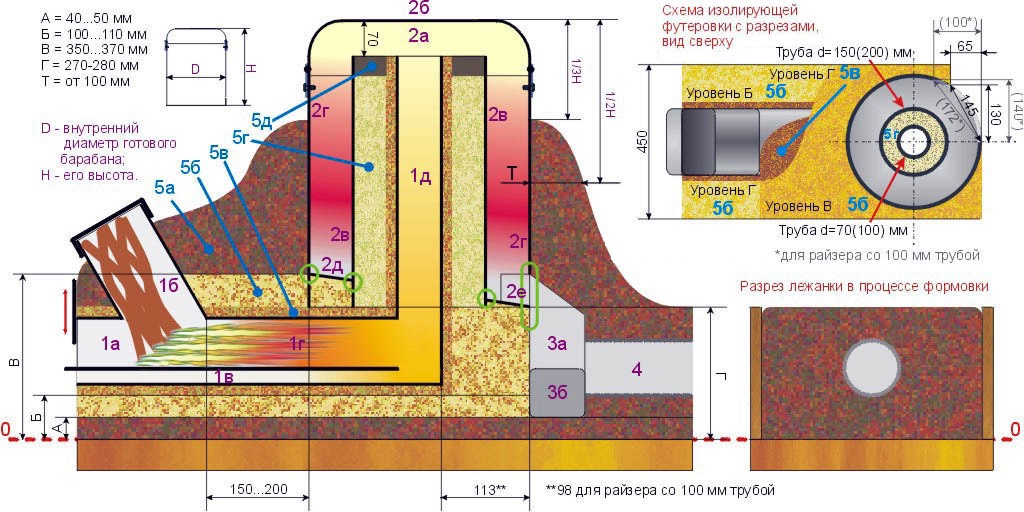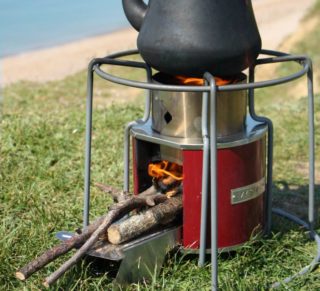When choosing the main functional component of a solid fuel heating system, in addition to efficiency, attention is paid to the duration of the work cycles and the convenience of maintenance. To implement the plan, taking into account the noted details, a rocket stove is suitable. The simplicity of the design implies the absence of excessive difficulties in the independent execution of work operations.
Varieties of rocket furnaces
The specific name is explained by a characteristic hum, which resembles the roar of the engines of a launching rocket. In more advanced designs, with the correct setting of the operating mode, the noise is reduced to a minimum level.
The classic scheme demonstrates the features of a jet stove. In this design, fuel is loaded vertically. Flames form in a horizontal section. With a sufficiently strong air supply, the stream of heated gases quickly unfolds by the wall of the main chamber. This provokes a vortex effect in the central part (riser), which increases traction. In the lateral canals, the walls are heated. Residual heat is accumulated in the lining of the outlet pipe connected to the chimney. This part is traditionally created in the form of a couch.
The rocket furnace has the following advantageous characteristics:
- high efficiency;
- the possibility of using wood waste, cones, other types of solid fuel;
- operational loading without interruption of the combustion process;
- lack of complex elements;
- minimum amount of waste (high temperature).
For objectivity, it should be noted the flaws of the rocket stove:
- the use of a water heat exchanger degrades the performance of the operating mode;
- in certain situations, carbon monoxide may enter the room;
- design power is not enough to fully heat a large property.
The appearance of such a structure is not everyone likes. However, this parameter is largely dependent on individual tastes. With the right finish, it’s not difficult to harmoniously match a particular style of interior.
The jet furnace in various modifications was used by the population of Japan, China, Korea, and other countries. Modern analogues while maintaining the basic principles differ:
- variety of designs;
- the use of new materials;
- accurate engineering calculation.
As an example, some stove-makers mention the Chinese Kang. However, this design is similar only to a long chimney, which is often installed under several beds along the walls. In an appropriate embodiment, this part performed the functions of a modern “warm floor” system. The furnace was created in a standard scheme with the obligatory device of a stove for cooking.
Russian stove
With maximum simplification, you can get the desired result:
- pipes are connected at right angles;
- in the horizontal part, a shelf for fuel is installed - 60% of the diameter below the top edge;
- the lower part of the hole forms an unregulated blow;
- the device is equipped with supports for fixing on a horizontal surface in the working position.
Gas cylinder stove
A factory product made of high-quality metal is a good basis for creating a home-made design. In addition to reliable welded joints, a gas cylinder is suitable for wall thickness.

When choosing components, sheet metal with a thickness of at least 5-6 mm should be used. The diameter of the main part of the structure is more than 30 cm.The door in the opening for loading fuel can adjust the air supply. Such an addition will prevent carbon monoxide from entering the room. If you intend to use the oven for cooking, cut off exactly the top of the container along with the valve. The hole is closed with a steel plate more than 5 mm thick, which is connected to the main part of the body by welding.
In the version without a lounger, the residual heat is not accumulated, so the efficiency is lower compared to the “classic” version of the stove.
It is recommended to insulate the inner chamber. Thick enough walls will help ensure that the temperature rises to + 950C ° and above. This is necessary for high-quality reproduction of the technological process. With this heating, complete combustion of the fuel with a minimum amount of ash is ensured.
Shirokov-Khramtsov furnace
This Russian modification is an improved version of the classical scheme. The main components of the Shirokov-Khramtsov kiln are created from an expensive concrete grade resistant to high temperatures. An accurate calculation significantly improved the stability of the operating indicators, which made it possible to place heat-resistant glass in the bunker zone to partially release infrared radiation towards the room. An improvised fireplace heats the room, serves as a spectacular decoration element.
Profile tube rocket furnace
For a trip, equipping a summer residence, solving other “temporary” problems, a mobile version of heating equipment is suitable. As a relevant example, you can use the Robinson furnace. The fuel and air supply is organized through a profile element (rectangular section 150 x 100 mm). The combustion zone is made of pipe. The divider at the outlet is used as a stand for heating dishes.
Other models
You can make a functional rocket stove with your own hands from 20 whole bricks and two halves. Such a structure is assembled literally in ten minutes on a prepared flat site. Thorough calculations and drawings are not needed. Work operations are performed without welding equipment and building mixtures. Fuel consumption is approximately 3-6 times less firewood compared with the "potbelly stove". It is permissible to use raw firewood, branches, fragments of old furniture.
Unlike a fire, this design retains heat for a long time. You can put dishes on a narrow hole. For convenience, they use a specialized support - a lattice of steel rods or cast iron. Even in such a simple version, high temperature is created in the working area, which contributes to complete combustion of fuel with minimal smoke.
Principle of operation
An ordinary bonfire does not ensure the rational use of fuel resources. A significant part of the energy is uselessly volatilized into the surrounding space. There are no convection processes, heat stores. It is not possible to fine-tune the combustion process. Access of oxygen is unlimited.
With the use of a chimney and a closed working area, the noted disadvantages are eliminated. However, a jet furnace has a higher efficiency compared to a typical "potbelly stove". The main difference is the chimney placed inside the main structure. An increase in the gas outlet path is accompanied by a gradual decrease in temperature in different areas (for example, values are given in C °):
- central shaft (riser): 700-1100;
- the gap between the walls: 250-380;
- plot under the bed: 30-90.
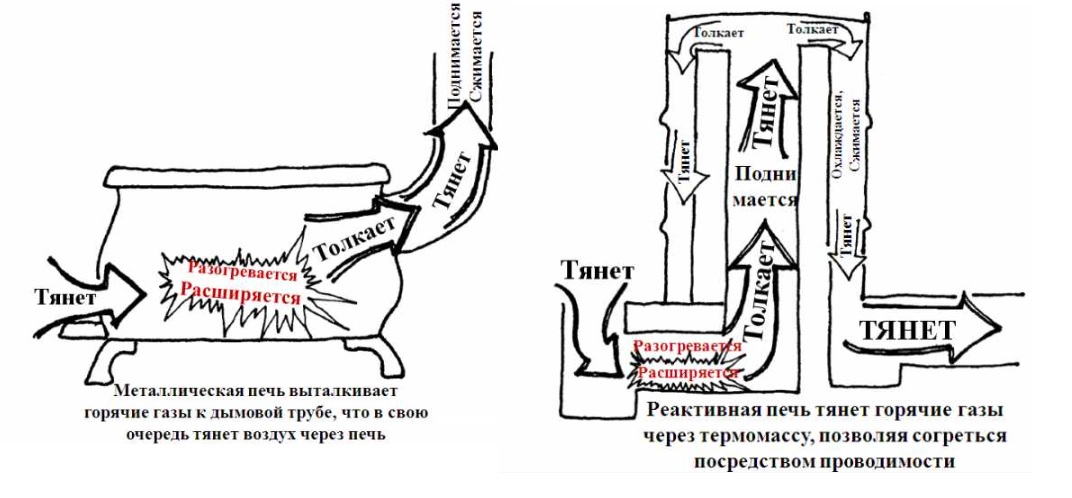
The figures show design features that provide sufficient traction while increasing the length of the smoke removal path. Another advantage is the high-temperature decomposition of organics with a limited supply of oxygen (pyrolysis).
If the do-it-yourself rocket furnace is created correctly, favorable conditions are provided for the formation of low molecular weight hydrocarbon compounds. Heating devices of this type are capable of providing an efficiency of more than 90%. Similar solutions are used in the design of long-burning solid fuel boilers.
Homemade design
In the absence of experience, you can choose a simplified design of several bricks, a bent pipe. If there are skills in handling the welding machine, create a furnace from a square profile and sheet metal.
Furnace drawing and dimensions
The presented option can be adjusted taking into account the volume of the room, other personal requirements and preferences. The developers recommend setting the diameter of the riser channel in the range from 65 to 105 mm. Resize the shell accordingly.
For the accumulation of thermal energy selected adobe. This material is not heat resistant, so the temperature must be reduced to a safe level. Additional recommendations:
- the drum can be made from a standard 50-liter bottle;
- ensure perfect tightness of the smoke exhaust system to prevent soot from entering the porous adobe;
- to remove residual solids install a second ash pan.
Step-by-step instruction
A do-it-yourself wood-fired jet stove can be created using the following algorithm:
- To produce a mixture of the main heat-insulating layer (5b), crushed stone from chamotte grade ШЛ is used.
- The support frame for the furnace is assembled from wooden logs (100 x 100) with cells no more than 600 mm, under the sunbed the distance can be increased.
- Mineral cardboard, dowel boards are used for cladding.
- Wooden preforms are pre-treated by impregnation with biocidal additives.
- The area under the main part of the structure is closed with a metal sheet.
- After placing the structure in the planned place, the formwork is installed, the adobe is poured.
- A drum is made from a suitable gas cylinder.
- To create reliable welded joints, electrodes with a diameter of 2 mm and a direct current of 60-70A are used.
- A sealing sealant is created from an asbestos cord, fixed with heat-resistant adhesive.
- A riser is assembled from prepared steel billets.
- The bottom layer of insulation is installed, plywood (20 mm) or boards are used for formwork.
- Filling with building mixture is carried out to level B according to the drawing. For complete drying of this part at room temperature, 1-2 days are needed.
- Install the furnace, controlling the accuracy of the vertical position.
- Part of the blower will protrude outward, so at the final stage the wall is leveled with adobe.
- After filling the mixture to level G, it is recommended to speed up the drying with a conventional 60-75 W incandescent light bulb (placed under the riser).
- Set an ash pan created from a steel sheet with a thickness of 0.8-1 mm.
- Mount the drum tube with the formation in the inner part of the wedge-shaped inclination to the exit (with a mixture of 5b).
- Create a lining with layer-by-layer filling (5 g), the cork is made of clay.
- Assembly continues according to the scheme, the corrugation, drum lid and ash pan are installed.
- After drying (2-25 weeks), the formwork is removed, the surface is formed, visible metal parts are painted.
Explanations for the composition of building mixtures (5):
- a - adobe made of clay and straw, the consistency of thick dough;
- b - clay of medium fat content with crushed stone from fireclay;
- c - chamotte sand with clay in proportions one to one;
- g - river sand without washing with a fixed granule size (2.5-3 mm);
- d - stove clay of medium fat content.
In advance, they acquire the tools and supplies needed to complete work operations. The list of purchases is based on the prepared project documentation.
How to heat a rocket furnace
Given the long path of the smoke exhaust system in a stationary structure, the need to start the operating mode after preliminary heating is understandable. When working with Robinson and other compact counterparts, this rule is not necessary. But a large furnace is first heated with dry shavings, paper, and other suitable consumables. For loading use a blower with an open door. The degree of readiness is estimated by the characteristic noise decay. At this stage, use the usual loading of fuel in the corresponding part of the furnace.
It is recommended to use the offset of the cover of the main hopper and the blower door for the operational setting of the operating mode. If there is too much oxygen, combustion is activated while blocking the pyrolysis process. In such conditions, fuel consumption indicators deteriorate, soot forms in the riser. It should be emphasized the difficulty of cleaning the closed central channel. In the worst situation, its throughput decreases to critically small values.
